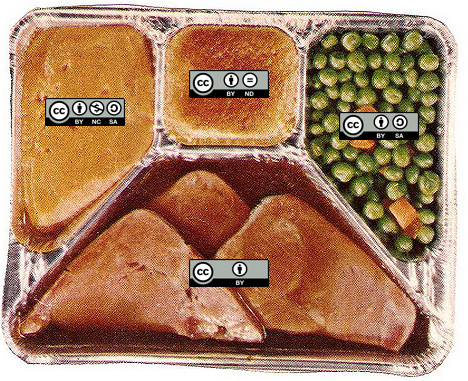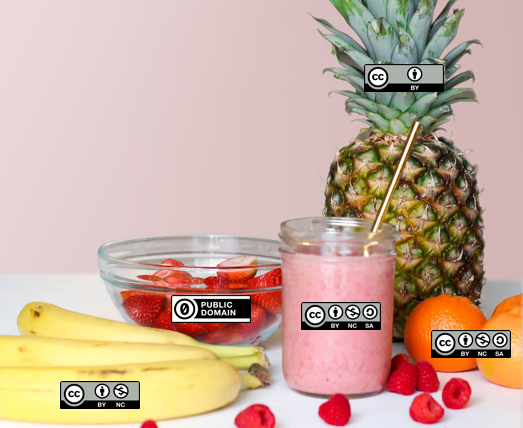Open Licensing for Education
First, if you have reproduced content for which you do not own the copyright or used content for which the license does not allow the use you wish to make, be sure to ask permission from the copyright holder. Then, if your course material combines contents under different licenses, here are some basic principles to keep in mind:
- Applying an open license to a project does not change the original copyright status of third-party content (even when reproduced with permission or under an exception)
- It is possible to apply an open license to an entire resource while individual elements have a different license or copyright status. However, it will depend on whether it is a collection or an adaptation.
 Definitions
Definitions
Collection

CC TV Dinner by Nate Angell is licensed under CC BY 4.0, and is a derivative of tv dinner 1 by adrigu used under CC BY 2.0, and various Creative Commons license buttons by Creative Commons used under CC BY 4.0.
A collection is a selection of existing materials still distinguishable once brought together (e.g. TV dinner).
With collections, existing content does not acquire a new license or copyright. There could be a new copyright or license on the addition of new content only (e.g. introduction, conclusion, commentary, cover).
Adaptation

CC Smoothie by Nate Angell is licensed under CC BY 4.0, and is a derivative of Strawberry Smoothie On Glass Jar by Element5 Digital under a Pexels License, and various Creative Commons license buttons by Creative Commons used under CC BY 4.0.
An adaptation is a combination of existing materials that are not easily distinguishable once combined (e.g. smoothie).
To acquire a new license or copyright, the new creation based on existing content needs to be original enough (i.e. involve skills, effort or judgement on the part of the creator of the adaptation). The new creation will then take the most restrictive license from the contents that were combined.
The CC License Chooser can help you decide on the appropriate license.
Add an Open License to Your Course Material
Where you add your chosen open license depends on the platform hosting the material and its format. For example:
- For a presentation, you will add the license on the first slide
- On a website, you will add it to the bottom of the page or on the page describing the site’s terms of use
- In a video or audio file, you will add the license in the description on the hosting platform and in the credits
 Activity: Applying Open Licenses
Activity: Applying Open Licenses
Assess your understanding of applying open licenses by completing this H5P.

